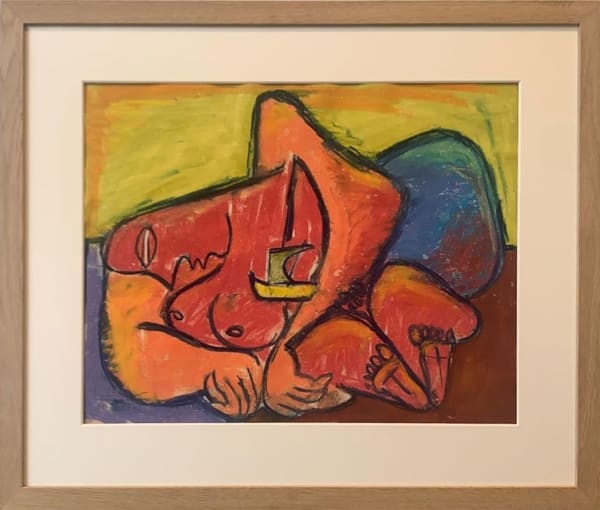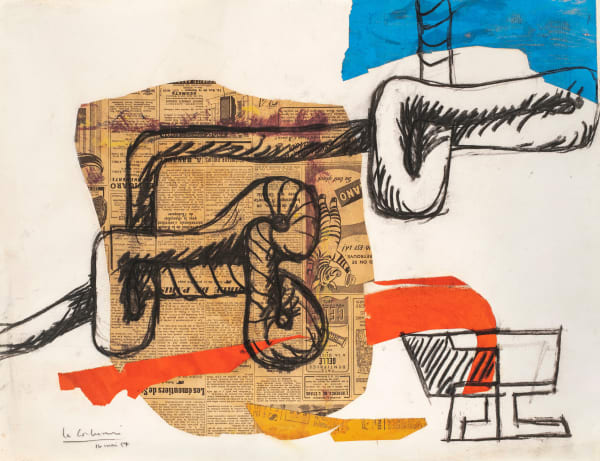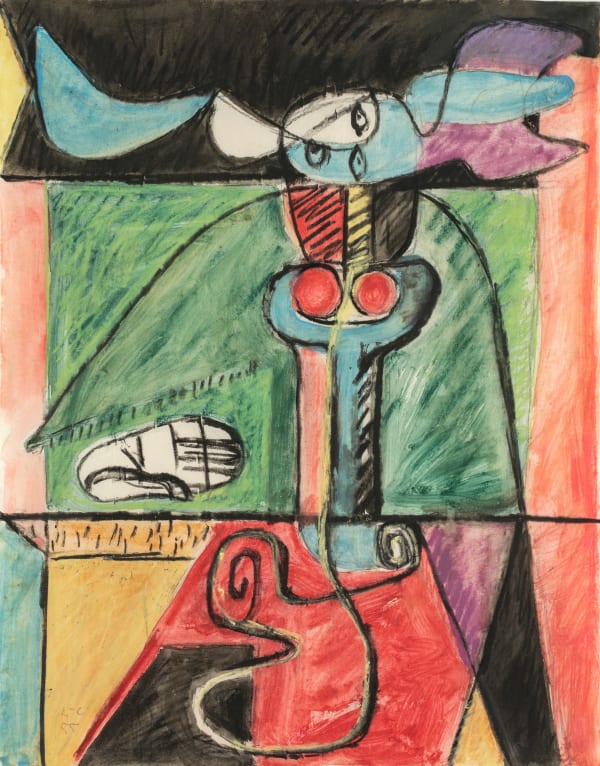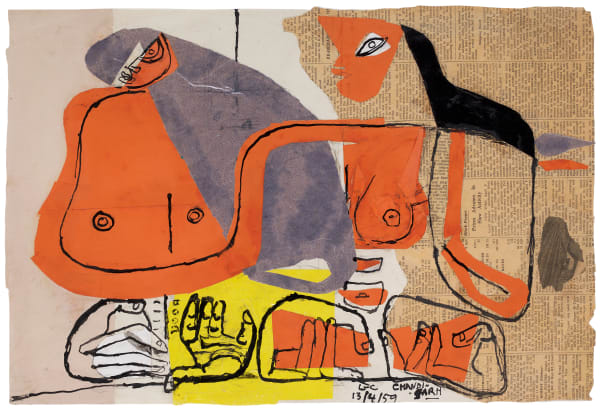Le Corbusier: Nomades By Le Corbusier
Le Corbusier began to include elements of nature, prominently incorporating the female figure which became almost the exclusive subject of his work in later years. Deux Femmes assises (1936) is a prime example of one of his earlier works depicting women, rendering them as robust figures in improbable scale.
After the war, Le Corbusier experimented with other media such as sculpture, murals, and tapestries, leaving behind ‘Purism’ and delving into a more selfless approach to art making. ‘Main ouverte’ became a recurring theme in his painting during this period, an open hand that symbolizes the message of giving and receiving. This was ultimately realized as a monumental sculpture for the city of Chandigarh in India, a dream project built 20 years after his death. Standing 26 meters high, the wind-activated, rotating metal sculpture is a testament to peace and prosperity, set amidst a backdrop of the Himalayas.
From 1952 he created a series of works called ‘Taureau’ a pictorial group of works depicting bulls that investigated mysticism and spirituality. This subject becomes the new icon of his work, replacing women. He wrote: “…And step by step, thirty years after, my mind occupied with other things and, with the possibility of using human figures to create a "bestiary", were born the successive deformations. And one day the discovery of a bull on my canvases appeared entirely beyond my control. There followed the development of the theme itself (the Bulls VIII to XIII approximately), and finally a change of sensibility with regard to the theme and a new distribution of the elements of the painting.”
(Source: Ronald Alley, Catalogue of the Tate Gallery's Collection of Modern Art other than Works by British Artists, Tate Gallery and Sotheby Parke-Bernet, London 1981, pp.415-16, reproduced p.415)
“The great richness of Le Corbusier’s pictorial work resides in the diversity that it takes on over the ages. It is born from the alchemy that the architect creates between a constantly reworked theme…Like all artists from his time, Le Corbusier benefited from an exceptional knowledge of classical culture, not only artistic but also mathematical, spiritual, and symbolic. Major exhibitions from recent years that show his paintings have enabled us to discover that beyond the occasional but undeniable influences from the great figures of the century whom he encountered such as Picasso, Léger, Matisse, or Miró, Le Corbusier is a cerebral painter, sometimes abstruse but always brilliant, who produced a very demanding and extremely coherent, yet nevertheless a completely personal work.” – Eric Mouchet, Expert on Le Corbusier
-
 Le CorbusierNature morte, pile d’assiettes, équerre et livre ouvert, 1919watercolor, gouache, and India ink on ochre woven paper60 x 50 cm (paper); 55,5 x 46,5 cm (drawing)
Le CorbusierNature morte, pile d’assiettes, équerre et livre ouvert, 1919watercolor, gouache, and India ink on ochre woven paper60 x 50 cm (paper); 55,5 x 46,5 cm (drawing)
framing dimensions: 82,3 x 72,3 x 4 cm -
 Le CorbusierEtude pour la Nature morte du Salon des Indépendants, 1922graphite on tracing paper14 x 23 cm
Le CorbusierEtude pour la Nature morte du Salon des Indépendants, 1922graphite on tracing paper14 x 23 cm
5 8/16 x 9 1/16 in
Framing Dimensions: 33,7 x 40,5 x 1,8 cm -
 Le CorbusierNature morte verticale, violon, boîte à violon, bouteilles, verres, 1922colored chalk, pastel, and graphite on laid paper26,3 x 19 cm (subject); 36,9 x 25,4 cm (paper)
Le CorbusierNature morte verticale, violon, boîte à violon, bouteilles, verres, 1922colored chalk, pastel, and graphite on laid paper26,3 x 19 cm (subject); 36,9 x 25,4 cm (paper)
framing dimensions: 58,3 x 46 cm -
 Le CorbusierDeux Femmes au Piquey, 1935washed pastel, ink and graphite lines on thin woven paper mounted on strong vellum20,8 x 31 cm
Le CorbusierDeux Femmes au Piquey, 1935washed pastel, ink and graphite lines on thin woven paper mounted on strong vellum20,8 x 31 cm
8 1/4 x 12 1/4 in
Framing dimensions: 40,4 x 50,4 x 8 cm -
 Le CorbusierDeux femmes assises, 1936washed pastel and ink on paper21 x 31 cm
Le CorbusierDeux femmes assises, 1936washed pastel and ink on paper21 x 31 cm
8 4/16 x 12 3/16 in
framing dimensions: 39 x 48 x 3 cm -
 Le CorbusierBouteilles et verres, 1944oil on plywood panel33 x 22 cm
Le CorbusierBouteilles et verres, 1944oil on plywood panel33 x 22 cm
12 15/16 x 8 10/16 in
framing dimensions: 41 x 3 x 4 cm -
 Le CorbusierOpus 5, 1948-1952chisel and aquatint on copper drawn in black with a slight background tone, printed in black on cream BFK de Rives vellum11,8 x 15,8 cm
Le CorbusierOpus 5, 1948-1952chisel and aquatint on copper drawn in black with a slight background tone, printed in black on cream BFK de Rives vellum11,8 x 15,8 cm
4 5/8 x 6 1/4 in
Framing dimensions: 39,5 x 34,4 cm -
 Le CorbusierDeux Femmes enlacées sur une jetée, avec une barque dans le lointain, 1949Collage of pieces of gouache paper, and black gouache (or casein)55,8 x 44 cm
Le CorbusierDeux Femmes enlacées sur une jetée, avec une barque dans le lointain, 1949Collage of pieces of gouache paper, and black gouache (or casein)55,8 x 44 cm
21 15/16 x 17 5/16 in
framing dimensions: 78 x 66 x 5 cm -
 Le CorbusierLes îles sont des corps de femmes immergés dans la mer qui accueillent les bateaux entre leurs bras, 1951pastel on paper45 x 55 cm
Le CorbusierLes îles sont des corps de femmes immergés dans la mer qui accueillent les bateaux entre leurs bras, 1951pastel on paper45 x 55 cm
17 3/4 x 21 5/8 in -
 Le CorbusierDeux Femmes autour d'un compotier et de deux tasses, 1952oil pastel and graphite on lined fine woven paper32,8 x 43,2 cm
Le CorbusierDeux Femmes autour d'un compotier et de deux tasses, 1952oil pastel and graphite on lined fine woven paper32,8 x 43,2 cm
12 7/8 x 17 1/8 in
Framing dimensions: 52 x 62 x 8 cm -
 Le CorbusierNature morte, 1953pastel, washed pastel, and graphite on paper23,9 x 35 cm
Le CorbusierNature morte, 1953pastel, washed pastel, and graphite on paper23,9 x 35 cm
9 3/8 x 13 3/4 in
Framing dimensions: 41 x 51,5 x 8 cm -
 Le CorbusierCorde et verres, 1954newspaper collage, gouache, and charcoal on paper48 x 62,5 cm
Le CorbusierCorde et verres, 1954newspaper collage, gouache, and charcoal on paper48 x 62,5 cm
18 7/8 x 24 5/8 in
framing dimensions : 85 x 71,2 x 8 cm -
 Le CorbusierTaureau, 1955pastel and washed pastel on woven paper56 x 43,9 cm
Le CorbusierTaureau, 1955pastel and washed pastel on woven paper56 x 43,9 cm
22 1/8 x 17 1/4 in
Framing dimensions: 76 x 64 x 8 cm -
 Le CorbusierMain ouverte, 1957collage, gouache and india ink on paper63 x 44.5 cm
Le CorbusierMain ouverte, 1957collage, gouache and india ink on paper63 x 44.5 cm
24 3/4 x 17 1/2 in
framing dimensions : 87,2 x 68 x 5,4 cm -
 Le Corbusier, Bonjour Calder, 1958-2022
Le Corbusier, Bonjour Calder, 1958-2022 -
 Le CorbusierLes Dés sont jetés, 1959collage on paper31 x 50,5 cm
Le CorbusierLes Dés sont jetés, 1959collage on paper31 x 50,5 cm
12 1/4 x 19 7/8 in
framing dimensions: 54 x 73 cm -
 Le CorbusierDeux Dames grecques, 1959collage on paper34 x 51 cm
Le CorbusierDeux Dames grecques, 1959collage on paper34 x 51 cm
13 3/8 x 20 1/8 in
framing dimensions: 58 x 73.5 cm -
 Le Corbusier, Etude pour sculpture Ubu - Panurge II, 1962
Le Corbusier, Etude pour sculpture Ubu - Panurge II, 1962 -
 Le Corbusier, Portrait Ozon et Georges, 1964
Le Corbusier, Portrait Ozon et Georges, 1964




















